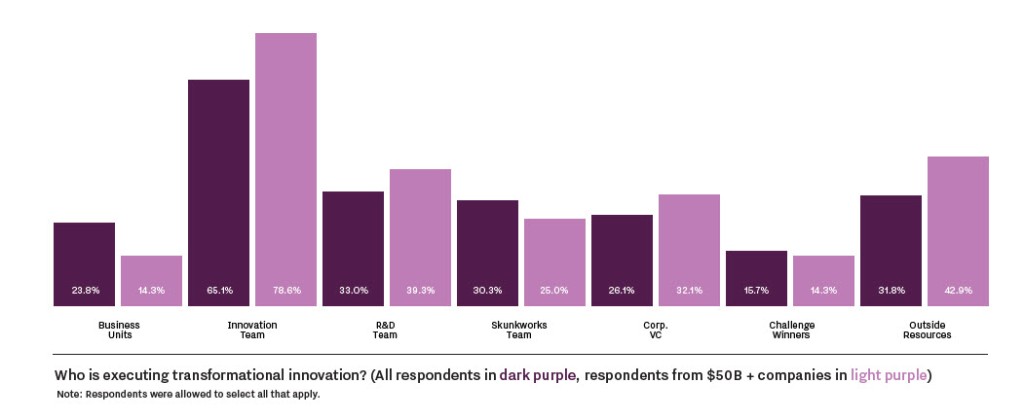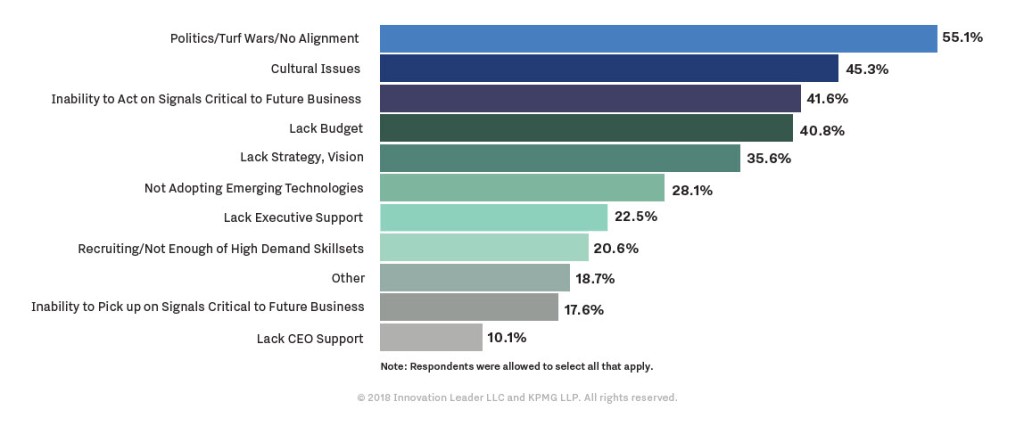 There has just been a highly useful benchmarking report released by Innovation Leader with KPMG LLP sponsoring this and providing some of their collective insights into the different aspects of “Benchmarking Innovation Impact 2018″
There has just been a highly useful benchmarking report released by Innovation Leader with KPMG LLP sponsoring this and providing some of their collective insights into the different aspects of “Benchmarking Innovation Impact 2018″
At present, you can download the report before it might slip behind a paywall at some later stage. I would take advantage while you can. The report provides insights from 270 innovation, R&D and strategy executives and considerable work on structuring the conclusions in highly thoughtful and valuable ways to the reader.
If you are not familiar with Innovation Leader, they were created to be a growing and essential resource for innovation, especially in the bigger organizations. It has a more specific focus on the US scene but much of what it has found is universal in my opinion. It’s editor and Co-Founder Scott Kirsner (editor@innovationleader.com) and his team are building a great point of reference and meeting point for innovators to exchange and learn from each other. Maybe you should join?
Why do I think the report is well worth you investing time to read? The report provides an excellent document that enables good discussions to be drawn from the benchmarking of many organization, to compare with your own organization. The report is laid out into four parts: 1. Creating Strategic Alignment, 2.Funding Innovation, 3 Delivering Impact and 4 Moving forward.
It offers up great suggestions on tactics, relationships and obstacles you can face in any sort of innovation program, be it an early forming one or at a more mature stage. It can allow you to communicate and suggest the needs for a new innovation approach where you need others involved but they would expect to see a validation. This report helps in all these and much more.
I am going to just focus on three parts that really caught my eye
These are 1 “Who Owns Innovation“, 2. “The Big Shift Occurring” and 3 “Obstacles to Innovation“. I have taken a visual from the report to support these focal points with permission, as this report is a copyright “2018 Innovation Leader LLC and KPMG LLP- all rights reserved report.”
Who Owns Innovation?

I pulled out this visual specifically on the transformation activity but as the whole report section on ownership of innovation discusses the differences, when it comes to breaking them down into incremental, adjacent and transformational innovation activities. Each has its own analysis. I chose the executing of transformational as it is the hardest but specifically to call attention to the array of groups working in this area.
We tend to focus on one group or another or hand it over to a separate innovation lab but here we actually see seven groups can be actively engaged in transformational innovation. This brings home the complexity of managing innovation, of aligning all of the different, sometimes conflicting activities and groups involved in innovation. Yet it is recognizing it is simply not “contained” to one specific group, even transformational innovation. I find that very valuable to be reminded about.
We are dealing with both internal and external groups that are more specialized and focused. Organizations are recognizing they can call upon different resources and dedicated groups to achieve transformational innovation.
The general Business Unit is less involved in transformation innovation but they will always have a key involvement and perhaps final say as they are more than likely going to promote or block the transforming ideas if they are not actively engaged. The dedicated Innovation team on the visual shows the main ‘spike’ which tends to follow today’s trend, for achieving a specific innovation focus and not being distracted you provide space for dedicated teams in different formats that ‘fit’ for you..
The one that is interesting, is that outside resources do show up at this current level, does indicate the growing recognition of larger organizations recognizing increasingly that going outside to specialists offers a very distinct level of separation to achieve breakthrough innovation. Outsiders offer a very different level of pairing, of business acumen and consumer empathy that is often not found in-house. This can give you a terrific access to different thinkers. draw in people with very different professional backgrounds that have design, engineering, and technology as their core.It really can transform thinking and product solutions.
It is good to see this outside engagement with specialist parties becoming an important part of any innovation transformational portfolio- the separation to focus in and providing a more diverse tapping into the outside resources that are available.
The Big Shift Occurring
 Where do organizations focus their energy and resources? There has been this commonly offered guide that a 70-30-10 ratio recommending incremental should be at 70%, adjacent at 30% and finally transformational at 10%. I have really detested this broad recommendation, it is in my opinion simply bad advice, without some detailed understanding of your market condition, your competitors, the changes we are undergoing to even make a rule-of-thumb recommendation as most simply just copy this blindly. Can you imagine a tech company on these ratios? They are more likely to be 10- 20- 70 or a company in the middle of significant industry changes working on these ratios, incrementing themselves to death?
Where do organizations focus their energy and resources? There has been this commonly offered guide that a 70-30-10 ratio recommending incremental should be at 70%, adjacent at 30% and finally transformational at 10%. I have really detested this broad recommendation, it is in my opinion simply bad advice, without some detailed understanding of your market condition, your competitors, the changes we are undergoing to even make a rule-of-thumb recommendation as most simply just copy this blindly. Can you imagine a tech company on these ratios? They are more likely to be 10- 20- 70 or a company in the middle of significant industry changes working on these ratios, incrementing themselves to death?
I would argue anyone trying to get out of the incremental trap needs to place increasing resource, energies, learning and funds towards adjacent and more specifically transformation. This is why I am glad this trend is underway and we see in this report nearly a 50- 25- 25 and that is really welcome. When we see a 35-30-35 as a recommendation I’ll be even happier but depending on your industries circumstances and need.
I was pleased to see this trend, it holds promise for the future of “better” innovation offerings that are more unique and radical. Do take a look at the industrial variations. The more we move towards transformational, the more we are thinking longer-term and that is a really important Big Shift.
Obstacles to Innovation
 There is so much written about obstacles. It is placed at the leadership door, it is in the poor innovation culture, or a lack of budget, poor visions or alignment. The list does go on and on. Two that really stand out for me and confirm what so many working in innovation often say (often quietly) are “Politics and Turf Wars” and “Inability to Act on Critical Signals of Change.” Just take another look, if you stop and take your time on the visual above they are number one and number three as the real issues.
There is so much written about obstacles. It is placed at the leadership door, it is in the poor innovation culture, or a lack of budget, poor visions or alignment. The list does go on and on. Two that really stand out for me and confirm what so many working in innovation often say (often quietly) are “Politics and Turf Wars” and “Inability to Act on Critical Signals of Change.” Just take another look, if you stop and take your time on the visual above they are number one and number three as the real issues.
Now the fact they come out so high indicates a really good underscoring of this report getting closer to the heart of innovation. The report points out the larger an organization gets the more turf wars and politics “kick in” to become such obstacles. It does affect all, large and small, and this raises one of the biggest issues of how can these inside blockages be successfully eliminated? We need to reflect on these and offer some better, lasting, solutions. We often see conflicting priorities, calling in favors, those “pet” project of a senior leader all become caught up in this turf war and politics. How can we reduce these down?
I have suggested we need a greater alignment and along with Jeffrey Philips in some of our past work, we have suggested and constantly practice the Innovation Executive WorkMat methodology, where the central part is the communication, cascading and constantly build the common language and it this document becomes the central one for innovation to draw from. In this workmat approach, you have seven parts: Strategic alignment, Culture, Environment, Structure and Processes, Governance, Common Language and Communications and finally, Motivations and Metrics.
It is this combined workmat approach, owned throughout the organization, that can begin to break down politics, turf wars, lack of vision, poor executive support, or failing to pick up opportunities, and miss signals of change. It also looks to give collective ownership.
In the Innovation Leaders report, KPMG has a specific section on “acting on signals of change” that is worth reading. Again as a constant champion of the Three Horizons methodology, we can begin to pick up weak signals of change that are all around us today and build those into the framing and innovation activities of incremental (h1), adjacent (h2) and transformational (h3)
So for me or any other person involved in innovation, this report is a must go too.
It is full of terrific insights covering many essential aspects of innovation management. It has a handy “key questions” and points to some very useful “resources after each of the sections discussed.
Finally, the report outlines the hallmarks of a mature innovation program and equally for those launching an innovation program. Great insights and learning just within this section.
I strongly recommend it as a report you can’t afford to miss.